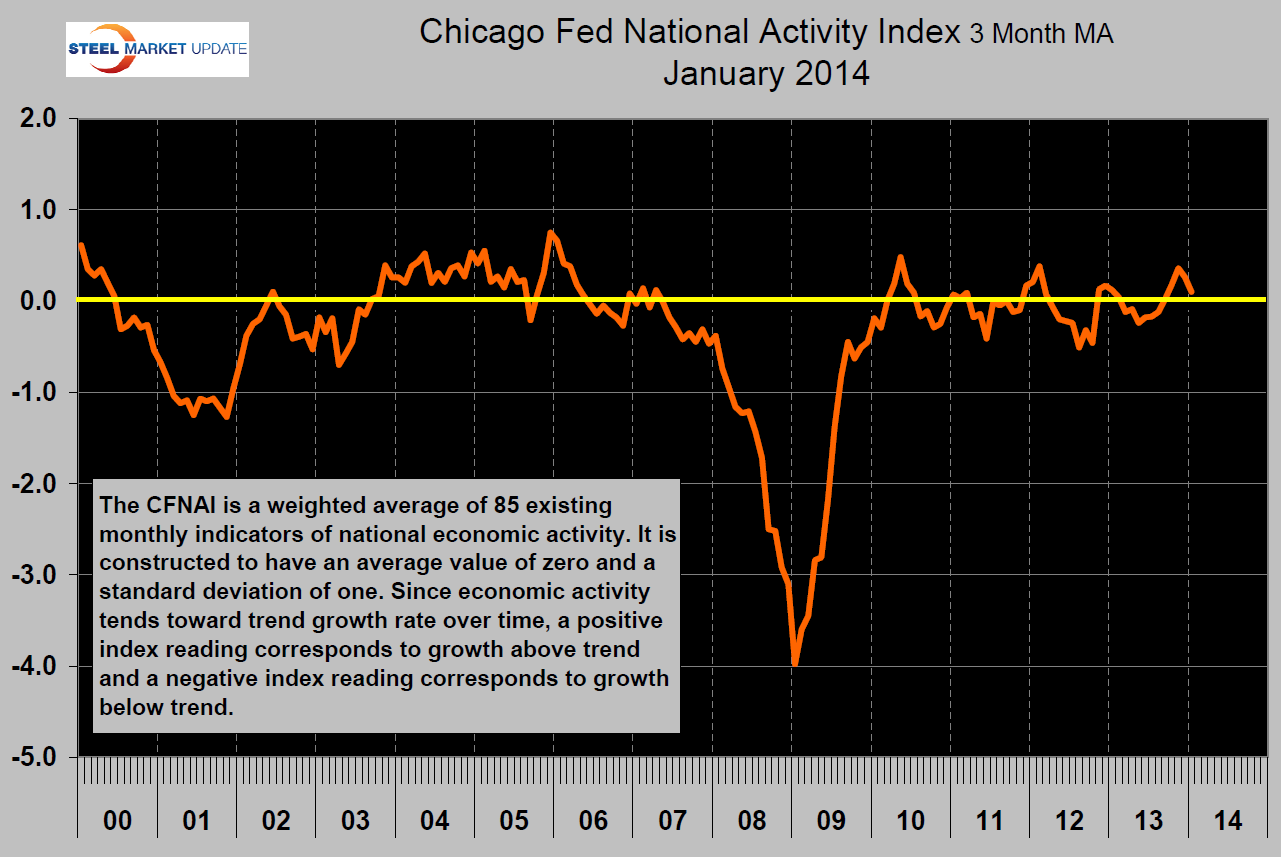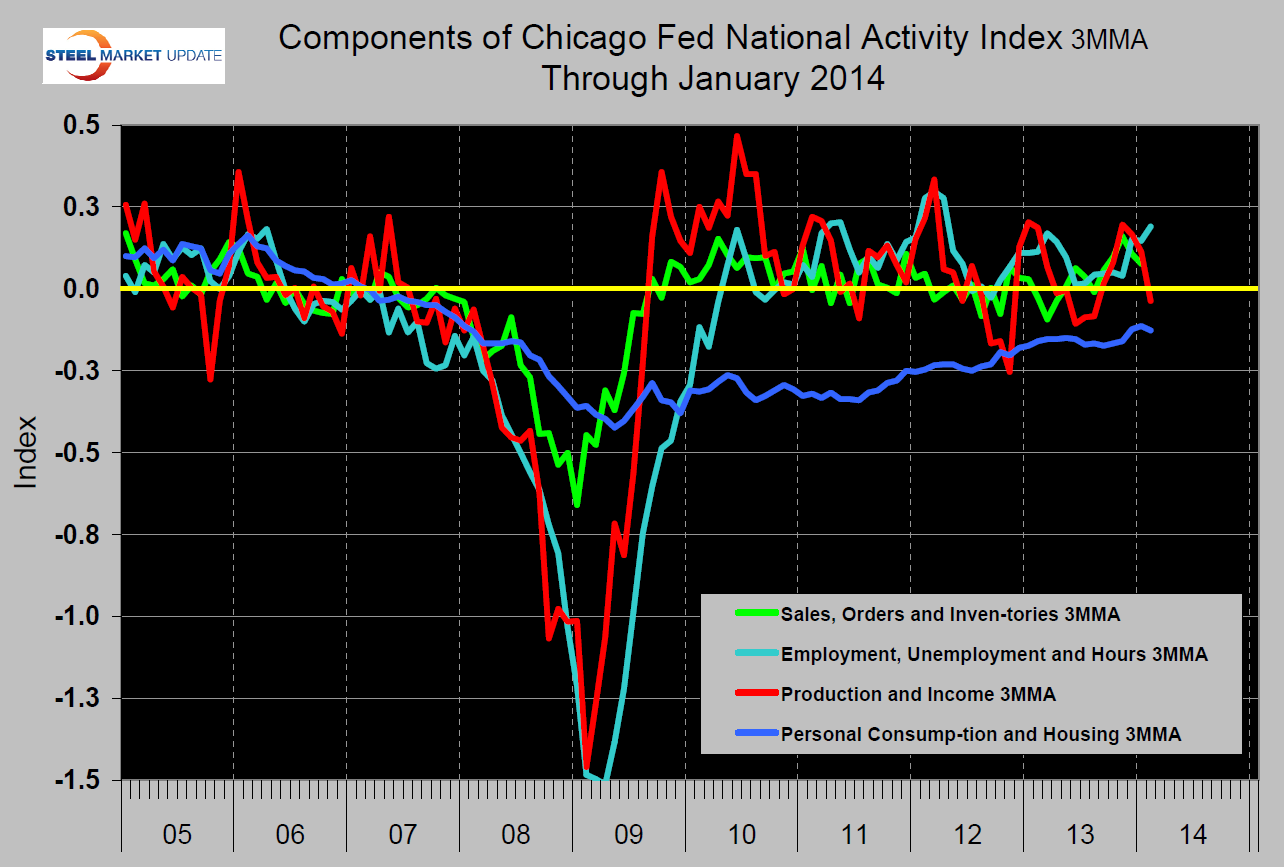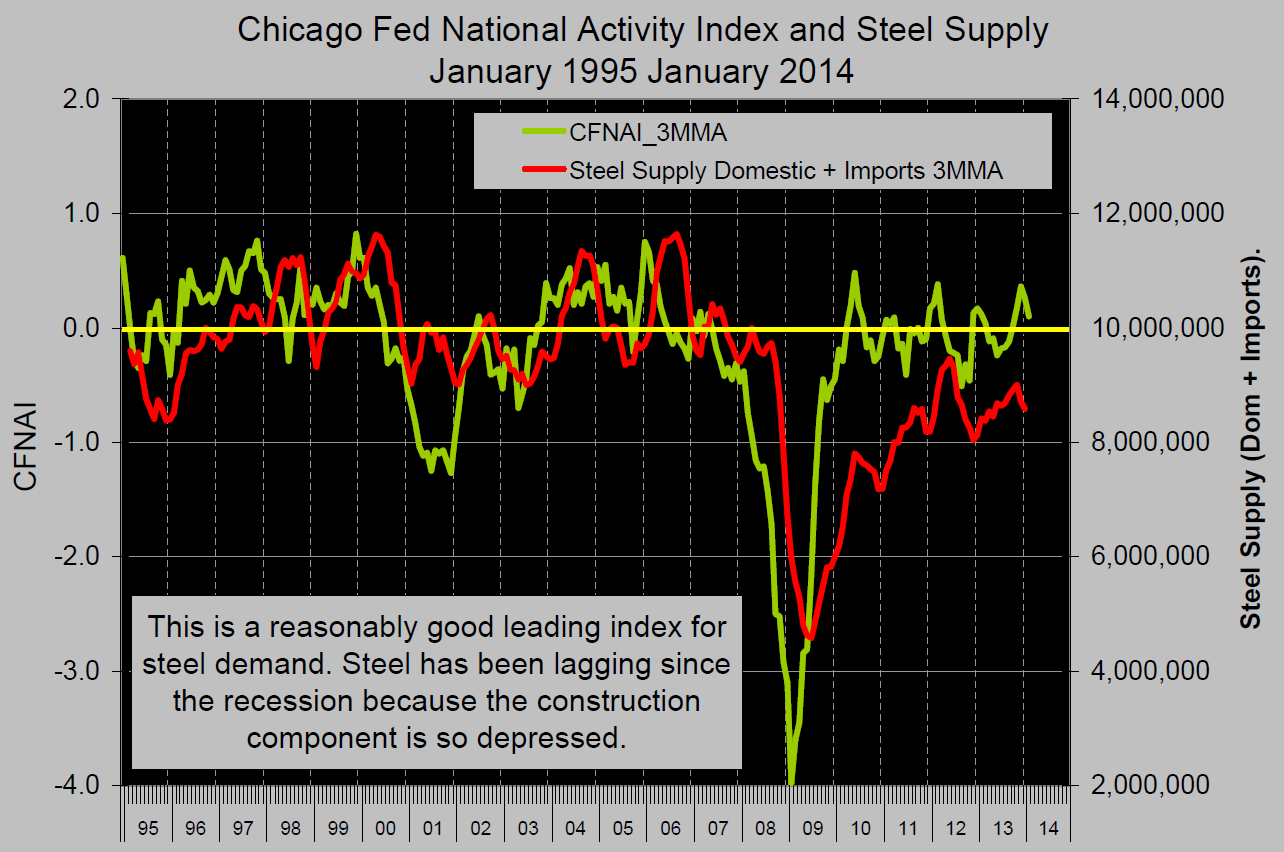Economy

The Chicago Federal Reserve National Activity Index (CFNAI) and Steel Supply
Written by Peter Wright
February 28, 2014
The following is an abridged version of the Chicago Federal Reserve statement plus our own graphical analysis. The CFNAI is an excellent reality check for much of the economic analysis that we routinely provide in The Steel Market Update. An explanation of the Index is provided at the end of this piece.
The official statement reads as follows: “Led by declines in production-related indicators, the CFNAI decreased to –0.39 in January from –0.03 in December. Two of the four broad categories of indicators that make up the index decreased from December, and two of the four categories made negative contributions to the index in January.
 The index’s three-month moving average, CFNAI-MA3, decreased to +0.10 in January from +0.26 in December, marking its fifth consecutive reading above zero. January’s CFNAI-MA3 suggests that growth in national economic activity was above its historical trend. The economic growth reflected in this level of the CFNAI-MA3 suggests limited inflationary pressure from economic activity over the coming year (Figure 1).
The index’s three-month moving average, CFNAI-MA3, decreased to +0.10 in January from +0.26 in December, marking its fifth consecutive reading above zero. January’s CFNAI-MA3 suggests that growth in national economic activity was above its historical trend. The economic growth reflected in this level of the CFNAI-MA3 suggests limited inflationary pressure from economic activity over the coming year (Figure 1).
Forty-one of the 85 individual indicators made positive contributions to the CFNAI in January, while 44 made negative contributions. Of the indicators that improved, ten made negative contributions. Production-related indicators contributed –0.36 to the CFNAI in January, down from +0.06 in December. Manufacturing output decreased 0.8 percent in January after rising 0.3 percent in December, and manufacturing capacity utilization decreased to 76.0 percent in January from 76.7 percent in the previous month.
Employment-related indicators contributed +0.13 to the CFNAI in January, up from +0.06 in December. The unemployment rate decreased to 6.6 percent in January from 6.7 percent in December, while nonfarm payrolls increased by 113,000 in January after rising by 75,000 in the previous month.
 The contribution from the sales, orders, and inventories category to the CFNAI increased to +0.02 in January from –0.01 in December. The contribution from the consumption and housing category to the CFNAI moved down to –0.18 in January from –0.14 in December. Housing starts declined to 880,000 annualized units in January from 1,048,000 in December, and housing permits declined to 937,000 annualized units in January from 991,000 in the previous month (Figure 2).
The contribution from the sales, orders, and inventories category to the CFNAI increased to +0.02 in January from –0.01 in December. The contribution from the consumption and housing category to the CFNAI moved down to –0.18 in January from –0.14 in December. Housing starts declined to 880,000 annualized units in January from 1,048,000 in December, and housing permits declined to 937,000 annualized units in January from 991,000 in the previous month (Figure 2).
The CFNAI was constructed using data available as of February 20, 2014. At that time, January data for 51 of the 85 indicators had been published. For all missing data, estimates were used in constructing the index. The December monthly index was revised to –0.03 from an initial estimate of +0.16. Revisions to the monthly index can be attributed to two main factors: revisions in previously published data and differences between the estimates of previously unavailable data and subsequently published data. The revision to the December monthly index was due primarily to the latter.”
 Figure 3 shows that the CFNAI has historically been a reasonably accurate leading indicator of steel demand (apparent supply) with a lead time of about six months. This is one of several benchmark indicator that shows steel demand has not recovered to its traditional level since the recession. We believe this to be a measure of the extent to which construction, (or lack there-of) is still a drag on steel demand.
Figure 3 shows that the CFNAI has historically been a reasonably accurate leading indicator of steel demand (apparent supply) with a lead time of about six months. This is one of several benchmark indicator that shows steel demand has not recovered to its traditional level since the recession. We believe this to be a measure of the extent to which construction, (or lack there-of) is still a drag on steel demand.
Explanation: The index is a weighted average of 85 indicators of national economic activity drawn from four broad categories of data: 1) production and income; 2) employment, unemployment, and hours; 3) personal consumption and housing; and 4) sales, orders, and inventories. A zero value for the index indicates that the national economy is expanding at its historical trend rate of growth; negative values indicate below-average growth; and positive values indicate above-average growth. When the CFNAI-MA3, (three month moving average) value moves below –0.70 following a period of economic expansion, there is an increasing likelihood that a recession has begun. Conversely, when the CFNAI-MA3 value moves above –0.70 following a period of economic contraction, there is an increasing likelihood that a recession has ended. When the CFNAI-MA3 value moves above /+0.70 more than two years into an economic expansion, there is an increasing likelihood that a period of sustained increasing inflation has begun.

Peter Wright
Read more from Peter WrightLatest in Economy

Architecture billings continue to slide in March
Architecture firms said billings continued to decline in March, according to the latest Architecture Billings Index (ABI) released by the American Institute of Architects (AIA) and Deltek.

Beige Book shows concerns about trade policy
Manufacturing was mixed, but two-thirds of districts said activity was little changed or had declined.

New York state manufacturing index drops again in April
Firms were pessimistic, with the future general business conditions index falling to its second lowest reading in the more than 20-year history of the survey

Construction adds 13,000 jobs in March
The construction sector added 13,000 jobs, seasonally adjusted, in March, but tariffs could undermine the industry.

Supply chains, end-users brace for impact from tariffs
Supply chains are working through what the tariffs mean for them
